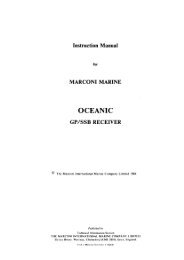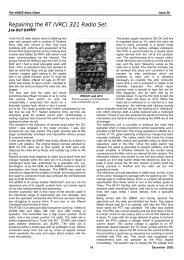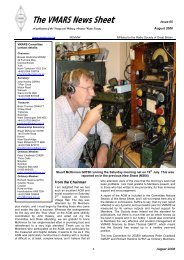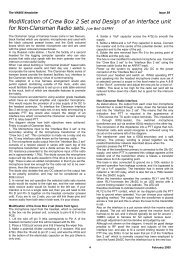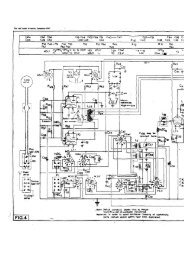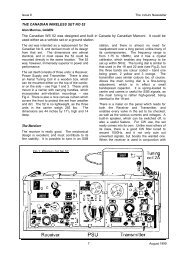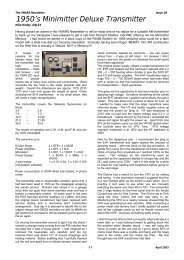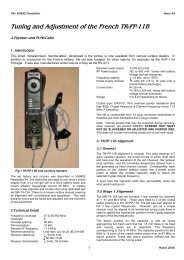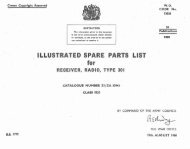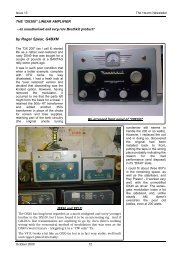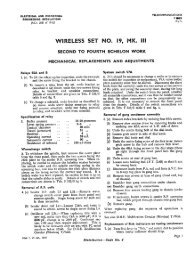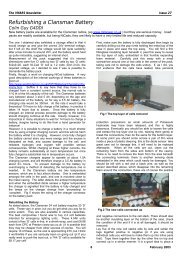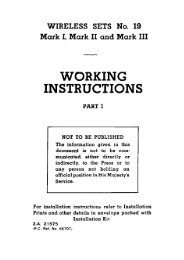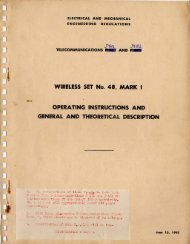2115_ Gee_MkII_Tropical.pdf - VMARSmanuals
2115_ Gee_MkII_Tropical.pdf - VMARSmanuals
2115_ Gee_MkII_Tropical.pdf - VMARSmanuals
Create successful ePaper yourself
Turn your PDF publications into a flip-book with our unique Google optimized e-Paper software.
12. Two traces are shown on the C.R.T.<br />
in the main time base position. The reason<br />
for this may be explained as follows. The<br />
pulse recurrence frequency of the " A "<br />
master station is 500 c/s and that of the " B "<br />
and " C " stations 250 CIS. The frequency<br />
of the complete time base is 250 c/s, so the<br />
C.R.T. displays two " A " pulses, one " B "<br />
pulse, and a " C " pulse. To obtain a time<br />
base of greatest length it is in effect, expanded<br />
VISIBLE TRACE<br />
* L<br />
START OF TRACE<br />
FLY 8AC K<br />
BLACKED OUT .<br />
Fig. 7.-Formation<br />
.t<br />
END OF TRACE<br />
of double time base.<br />
to twice the width of the tube and then<br />
" divided " at its mid point, see fig. 5.<br />
Thus one " A " pulse and the " B " pulse<br />
appear on one half, and the other " '4 "<br />
pulse and the " C " pulse appear on the other<br />
half. This effect of " dividing " is obtained<br />
by causing the time base to sweep the rube<br />
twice as fast (i.e. 500 crs) and by applying<br />
simultaneously a 250 cis square wave to<br />
the Y plates so displacing alternate sweeps.<br />
I . A crystal-controlled oscillator and<br />
its associated divider circuit is housed in<br />
the indicating unit. The frequency of the<br />
oscillator may be controlled ~vithin fine limits<br />
and it has a two-fold function ; it provides a<br />
stabilised scource of frequency whereby the<br />
frequency of the time base may be phased<br />
accurately to the ground stations ; and it<br />
generates " calibration pips " which may be<br />
fed to the Y plates of the C.R.T. at \{.ill.<br />
to facilitate the use of the apparatus.<br />
14. The follow in^ controls, sockets and<br />
plugs are provided on the front panel of<br />
the indicating unit.<br />
(i) E.H.T. switch - controls the 80v.<br />
a.c. supply to the E.H.T. Transformer<br />
and the receiver H.T. Transfromer<br />
and therefore controls both<br />
H.T. and E.H.T. in the indicating<br />
unit.<br />
(ii) Pye plug coloured blue. The input<br />
plug to the Y plates of the C.R.T.<br />
from the receiver.<br />
(iii) 6-pin Wplug. Supplies power to the<br />
indicating unit, and on pin 3, the<br />
connection whereby the receiver<br />
gain is controlled at the indicating<br />
I<br />
unit.<br />
(iv) Gain control. Enables the gain of<br />
the receiver to be varied.<br />
(v) Clearing switch. With this 2-position<br />
switch either calibration pips generated<br />
by the dividers, or the output '<br />
of the receiver, may be applied to<br />
the Y plates of the C.R.T.<br />
(vi) Time base switch. This 3-position<br />
switch enables either the main time<br />
base, strobe time base, or expanded<br />
strobe time base to be selected.<br />
(vii) Focus control for adjusting the focus<br />
of the trace on the C.R.T.<br />
(viii) Brilliance control for adjusting the<br />
brilliance of the trace on the C.R.T.<br />
(ix) " B " strobe coarse control and " B "<br />
srrobe fine control which together<br />
enable the position of the " B "<br />
strobe time base to be moved along<br />
the " B " main time base.<br />
(x) " C " strobe coarse control and " C "<br />
srrobe fine control which together<br />
enable the position of the " C"<br />
strobe time base to be moved along<br />
the " C " main time base.<br />
(xi) Fine-fiequenc~ oscillator control. This<br />
enables the frequency of the master<br />
oscillator to be controlled within<br />
fine limits.<br />
(xii) Recurrence frequency switch. This<br />
is provided to give an alternative<br />
divider ratio so as to overcome the<br />
difficulty of presenting pulses which<br />
occur. at different recurrency frequency.<br />
15. Further information on the indicating<br />
unit and the circuit description are<br />
provided in para. 55 to 92. Fig 6 shows a<br />
block schematic diagram, fig. 40 a circuit<br />
diagram. and fig. 3 1 - 34, annotated pictorial<br />
views of the interior. Specimen oscillograms<br />
are given in fig. 35 - 38.<br />
Control panel, type 3.<br />
16. The control panel, type 3 is described<br />
in full in A.P. 1186D, Vol. I, Sect. I, Chap. 1<br />
to which reference should be made for complete<br />
information. Briefly, the function of<br />
the control panel is to stabilise the output<br />
of the 80 volts, a.c. generator which supplies<br />
a.c. to the equipment. It incorporates a<br />
carbon pile regulator which is connected<br />
in the field circuit of the alternator, and a<br />
suppressor whose function is to prevent -<br />
the slot ripple in the field from being fed out<br />
of the control panel.



